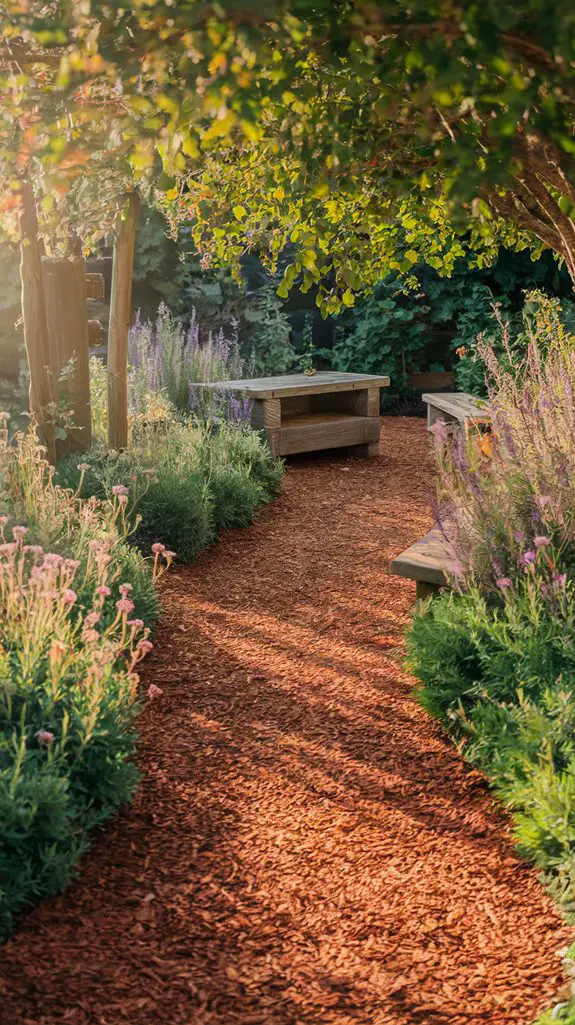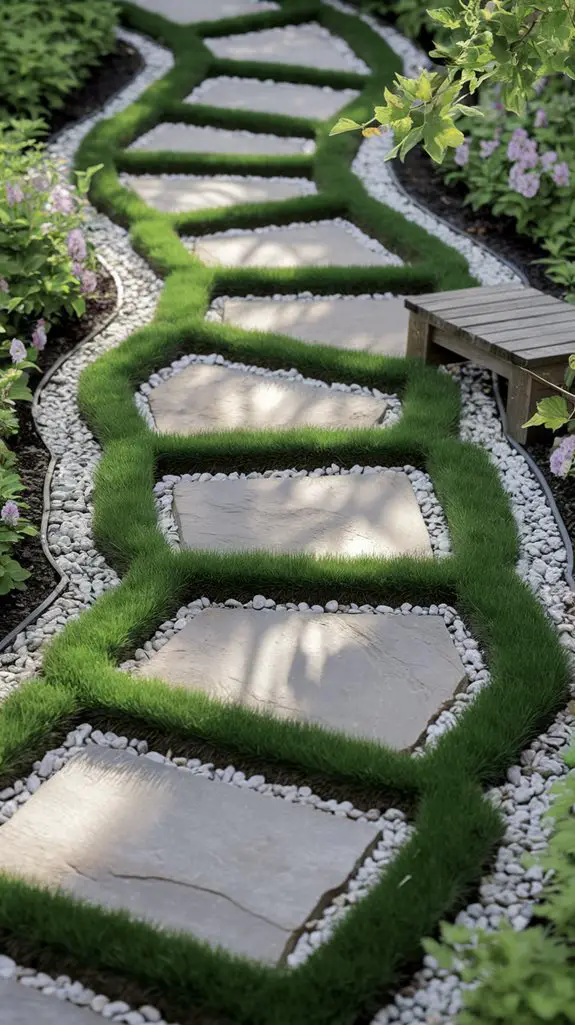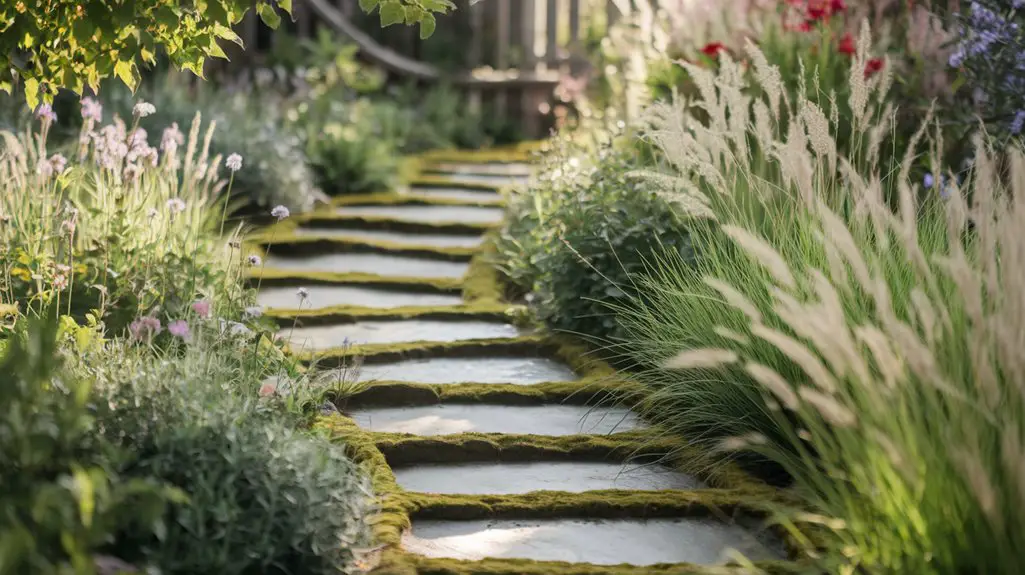Your garden deserves pathways that won’t consume your limited time. You’ll find several low-effort solutions that deliver both functionality and aesthetic appeal without requiring constant maintenance. From quick-install gravel paths that need only minimal excavation to pre-cast pavers that transform spaces in a weekend, these walkway options accommodate your busy schedule. The right materials and installation techniques will dramatically reduce your future garden workload while enhancing your outdoor living experience.
Quick-Install Gravel and Stone Pathways
Versatility makes gravel and stone pathways a standout choice for garden owners seeking rapid installation solutions. These permeable surfaces provide excellent drainage while accommodating irregular terrain with minimal site preparation.
For best results, excavate to a depth of 4-6 inches, install landscape fabric as a weed barrier, then layer with 2-3 inches of coarse aggregate base. Top with your selected decorative stone—consider angular gravel (¼-½ inch) for stability or rounded river rock (¾-1½ inch) for aesthetic appeal.
Incorporate metal, plastic, or stone edging to prevent migration and maintain crisp borders. Additionally, selecting the right type of decorative stone can enhance both the function and appearance of your pathway.
You’ll find installation can be completed in a weekend, requiring only basic tools: tape measure, spade, tamper, and rake. For high-traffic areas, compress the aggregate thoroughly to prevent shifting and promote longevity.
Low-Cost Mulch Solutions for Natural Walkways

Pine needles, wood chips, and shredded bark offer cost-effective alternatives for garden walkways while creating a naturalistic aesthetic that harmonizes with surrounding plantings. You’ll find these materials readily available at garden centers or potentially free from local tree services. Apply mulch 2-3 inches deep, creating defined edges using landscape timbers or stones for containment.
| Material | Longevity | Cost/sq.ft |
|---|---|---|
| Pine Needles | 1-2 years | $0.15-0.30 |
| Wood Chips | 2-3 years | $0.20-0.40 |
| Shredded Bark | 2-4 years | $0.35-0.60 |
For ideal durability, install landscape fabric beneath your mulch pathway to suppress weeds while maintaining permeability. Refresh annually with a thin layer to maintain pathway definition and compensate for natural decomposition. These biodegradable solutions enrich soil structure over time while providing cushioned footing throughout your garden space. Additionally, using mulch can enhance soil health by promoting beneficial microorganisms and improving moisture retention.
Time-Saving Stepping Stone Designs

Beyond mulch options, stepping stone pathways offer garden owners durable structure with minimal installation time. Pre-cast concrete pavers in geometric or organic shapes can be positioned directly onto leveled soil without extensive excavation.
Opt for interlocking modular systems that eliminate precise spacing requirements—simply press units into position following the manufacturer’s offset pattern guidelines.
For expedited installation, consider lightweight composite alternatives that weigh 75% less than concrete while maintaining comparable load-bearing capacity.
Space stones at comfortable stride length (24-28 inches center-to-center) to create natural pacing. Apply polymeric sand between joints on formal layouts to inhibit weed growth and stabilize positioning.
For established gardens, select elevated stepping stones with minimal ground contact to prevent disruption of existing root systems while providing immediate functionality without extensive ground preparation. Incorporating color theory can enhance the visual appeal of your pathway, guiding the eye and creating a harmonious flow throughout the garden.
Durable Paver Options for High-Traffic Areas
When selecting materials for frequently traversed garden pathways, porcelain and natural stone pavers deliver exceptional longevity with minimal maintenance requirements.
These materials withstand environmental stressors while maintaining structural integrity throughout seasonal changes.
For ideal durability in high-traffic zones, consider these premium paver options:
- Porcelain pavers – Offering 1,800+ PSI compressive strength, with frost-resistant properties and non-porous surfaces that resist staining and algae growth.
- Granite pavers – Delivering unparalleled hardness (7-8 Mohs scale) with dimensional stability and resistance to abrasion.
- Bluestone pavers – Providing natural cleft textures that maintain slip resistance even when wet, with thermal stability preventing excessive heat retention.
Select pavers with minimum 2″ thickness for vehicular areas and implement proper sub-base construction with geotextile fabric to prevent settling and maximize installation lifespan. Additionally, ensure proper raised garden bed maintenance to keep your garden healthy and thriving alongside your pathways.
Weekend Projects: Wooden Walkway Systems
Wooden walkway systems provide an accessible weekend project option for garden enthusiasts seeking to enhance their outdoor space with minimal specialized equipment. You’ll need standard carpentry tools: circular saw, drill, tape measure, and level. Pre-cut cedar or pressure-treated pine planks (1″×6″) offer ideal dimensions for most applications.
Begin by establishing your pathway’s contour using stakes and string. Excavate 2″ of soil, then lay weed barrier fabric before installing a 1″ gravel base. Construct simple frame sections using 2″×4″ lumber as joists at 16″ intervals. Secure planks perpendicular to joists using weather-resistant deck screws, maintaining ¼” gaps between boards for drainage.
Elevate your design by incorporating rounded edges, recessed lighting, or contrasting wood species for border details. Additionally, consider creating beautiful pathways that blend seamlessly with the natural landscape for enhanced visual appeal.
Apply a penetrating sealer to extend longevity and preserve the natural grain character.
No-Mowing-Required Border Techniques
Creating maintenance-free borders alongside your garden walkways eliminates tedious edge trimming while establishing clear visual boundaries between pathways and plantings.
Implement hardscape edging solutions that provide both functional separation and aesthetic appeal without requiring regular maintenance.
For ideal no-mow borders, consider these professional-grade solutions:
- Metal Edging – Install 1/8″ thick steel or aluminum strips, sunk 3″ into soil with exposed edge 1/2″ above grade to prevent rhizome infiltration.
- Stone Borders – Position cobblestone, flagstone, or brick in mortared arrangements to create permanent delineation.
- Composite Barriers – Utilize recycled plastic edging with UV inhibitors that won’t deteriorate or require seasonal treatments.
Complement these installations with mulched buffer zones of 4-6″ width to further suppress unwanted vegetation encroachment and reduce maintenance requirements throughout the growing season. Additionally, creative pathways can enhance the overall aesthetic of your garden while providing practical access to various areas.
Conclusion
Your garden’s circulation system deserves more than that sad, muddy footpath you’ve been trudging along. You’ll thank yourself for investing a weekend in one of these low-maintenance walkway solutions. Whether you’ve opted for permeable aggregate pathways, organic mulch circulation routes, or modular paver installations, you’ve now created defined shifting spaces that elevate your landscape’s design coherence while sparing you the weekly ritual of edge trimming and weed extraction.



